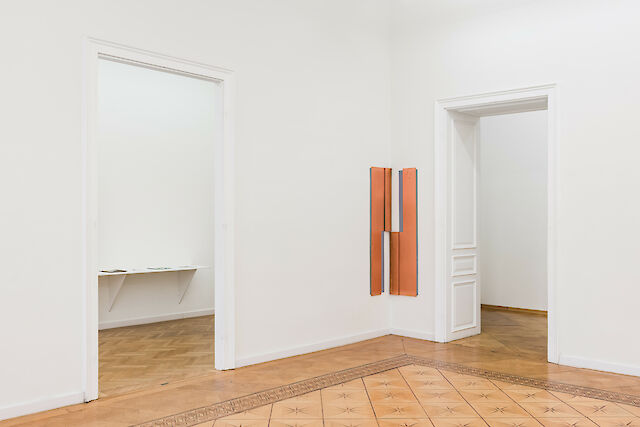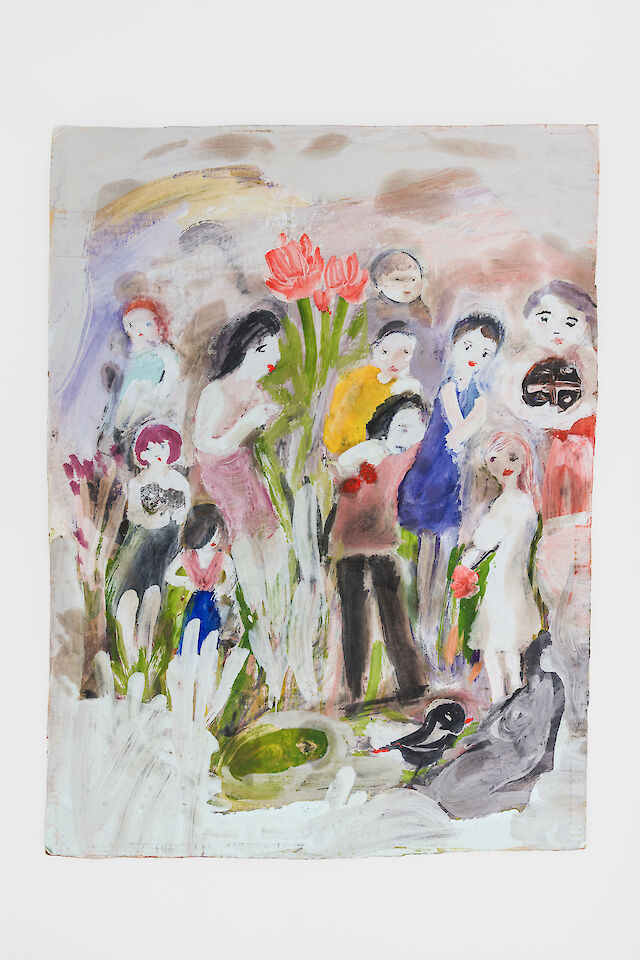Images
Olga Balema, Elene Chantladze, Birke Gorm, Ernst Yohji Jaeger, Marie Lund
28. 1. – 12. 3. 2022

Installation view, Olga Balema, Elene Chantladze, Birke Gorm, Ernst Yohji Jaeger, Marie Lund, Croy Nielsen, Vienna, 2022

Installation view, Olga Balema, Elene Chantladze, Birke Gorm, Ernst Yohji Jaeger, Marie Lund, Croy Nielsen, Vienna, 2022

Birke Gorm, I CAN SMILE AT THE PAST no. 12 (The Mayor), and I CAN SMILE AT THE PAST no. 11 (The Pagan Woman), 2022, Jute fibres, metal, each 200 × 100 cm

Birke Gorm, I CAN SMILE AT THE PAST no. 12 (The Mayor), 2022, Jute fibres, metal, each 200 × 100 cm

Birke Gorm, I CAN SMILE AT THE PAST no. 11 (The Pagan Woman), 2022, Jute fibres, metal, each 200 × 100 cm

Marie Lund, Alibi, 2020, Copper, rubber, hardware, Each plate: 120 × 50 cm

Installation view, Olga Balema, Elene Chantladze, Birke Gorm, Ernst Yohji Jaeger, Marie Lund, Croy Nielsen, Vienna, 2022

Installation view, Olga Balema, Elene Chantladze, Birke Gorm, Ernst Yohji Jaeger, Marie Lund, Croy Nielsen, Vienna, 2022

Ernst Yohji Jaeger, Untitled, 2016, Oil on canvas, 60 × 46 × 3 cm, 62 × 48 × 3 cm (framed)

Installation view, Olga Balema, Elene Chantladze, Birke Gorm, Ernst Yohji Jaeger, Marie Lund, Croy Nielsen, Vienna, 2022

Marie Lund, Alibi, 2020, Copper, rubber, hardware, Each plate: 160 × 40 cm

Elene Chantladze, installation view, Olga Balema, Elene Chantladze, Birke Gorm, Ernst Yohji Jaeger, Marie Lund, Croy Nielsen, Vienna, 2022

Elene Chantladze, Untitled, 1999, Untitled, and Chemi Deida Futsu Ojakhit (My Aunt Futsu With Family), Mixed media on cardboard, various sizes, Courtesy of LC Queisser, Tbilisi

Installation view, Olga Balema, Elene Chantladze, Birke Gorm, Ernst Yohji Jaeger, Marie Lund, Croy Nielsen, Vienna, 2022

Olga Balema, Untitled, 2021, Wood, foam, latex, 45.5 × 35.5 × 20 cm

Installation view, Olga Balema, Elene Chantladze, Birke Gorm, Ernst Yohji Jaeger, Marie Lund, Croy Nielsen, Vienna, 2022

Olga Balema, Untitled, 2021, Wood, foam, latex, 40 × 45 × 12 cm

Installation view, Olga Balema, Elene Chantladze, Birke Gorm, Ernst Yohji Jaeger, Marie Lund, Croy Nielsen, Vienna, 2022

Elene Chantladze, Visitors in Tskaltubo, Mixed media on cardboard, 36.5 × 27.5 cm, Courtesy of LC Queisser, Tbilisi

Elene Chantladze, Untitled, Mixed media on cardboard, 16 × 25 cm, Courtesy of LC Queisser, Tbilisi

Elene Chantladze, Untitled, Mixed media on cardboard, 20 × 16.5 cm, Courtesy of LC Queisser, Tbilisi

Elene Chantladze, Meeting, 2009, Mixed media on cardboard, 29 × 21 cm, Courtesy of LC Queisser, Tbilisi

Elene Chantladze, Untitled, 1999, Mixed media on cardboard, 27 × 28 cm, Courtesy of LC Queisser, Tbilisi

Elene Chantldaze, Untitled, Mixed media on cardboard, 37 × 27.5 cm, Courtesy of LC Queisser, Tbilisi

Elene Chantladze, Chemi Deida Futsu Ojakhit (My Aunt Futsu With Family), Mixed media on cardboard, 28.5 × 21 cm, Courtesy of LC Queisser, Tbilisi

Elene Chantladze, Untitled, 2019, Mixed media on cardboard, 34 × 26.5 cm, Courtesy of LC Queisser, Tbilisi

Elene Chantladze, Untitled, Mixed media on cardboard, 11.4 × 10.5 cm, Courtesy of LC Queisser, Tbilisi

Elene Chantladze, Alekos Dabadebis Dghe, 25.01.2019, Mixed media on cardboard, 30 × 25.5 cm, Courtesy of LC Queisser, Tbilisi

Elene Chantladze, Untitled, Mixed media on cardboard, 29 × 25.5 cm, Courtesy of LC Queisser, Tbilisi
Photos by Kunst-dokumentation.com
Press Release
This is a group show bringing four artists from our program together with the work of Elene Chantladze (b. 1946, Supsa, Georgia).
Oliver discovered Elene Chantladze a couple of years ago through LC Queisser in Tbilisi. She lives and works in Tskaltubo in Georgia. In lack of money, she used to draw on stones, using matches or her fingers, and she still paints on discarded materials. Ser Serpas once wrote, upon seeing a painting of hers firsthand, that “well, you see her hand, how she has analyzed and brought to light what was under the surface of the stone, or the piece of cardboard“(1). Her work is populated by humans and animals, in a mix of washy colours and looping lines. They hover on the edge of abstraction and are never alone: they interact with each other, dancing or jostling in a crowd. Or dearly holding a butterfly. Sometimes they merge into a mass of intertwined lines.
Olga Balema (b. 1984, Lviv, Ukraine) used to live in Berlin and so did we. She is a sculptor. In 2015 she filled our Berlin gallery with sculptures slowly dissolving themselves from within. The two works included here are made of wood, foam, and latex. Their shapes are created by putting together the wood, and then breaking it several times over and over again, before it is stretched with foam and painted with latex. Then it is broken again. We installed these wall mounted sculptures in the same space as Elene Chantladze’s drawings, that are presented on a long sideboard without any glass or framing.
We first met Ernst Yohji Jaeger (b. 1990, Frankfurt, Germany) during his degree show at the Academy of applied Arts here in Vienna. His paintings — mostly modest in size — stroke us as dreamlike and sensual, conveying a sense of solitude. Untitled (2016) was made long before he had his first solo show with us a year ago. It is hanging on its own in the smallest space of the gallery, but it is also the wall allowing one to look at it from the furthest distance, when standing in the main space. The painting oscillates between distance and intimacy, and the pale chrysalis like figure gazes into a luminous blue. The rich impasto, accentuated by the underlying vibrant bright orange (which he often uses in his paintings), coalesces form and feeling.
Marie Lund (b. 1976, Copenhagen, Denmark) has been part of our program since the beginning. We did five solo shows together, two of which were here in Vienna. In the first one her sculptures were vertically oriented towards the wooden door frames. In the second one they retired horizontally to the space between floor and wall, or wall and ceiling. The series presented here, takes the form of door hinges, scaled-up to parts of the human body. The change in size and context of these familiar and banal objects make them seem unfamiliar and strange. Positioned in opposite corners, they articulate the architecture as a second skin, and work as a sort of framing device. For example when one is looking at Ernst’s painting from a distance.
In 2018 we presented Birke Gorm (b. 1986, Hamburg, Germany) and Marie together at CHART Art Fair in Copenhagen. They hadn’t met before, but they have occasionally been collaborating since then. Birke also grew up in Denmark, but she studied here in Vienna, and for her first show with us she covered the walls in mud. I can smile at the past is a series of tapestries in which she basically uses the canvas itself as both medium and carrier, as the motives appear by means of skilfully applied jute threads. The images stem from the famous Basel’s Dance of Death — a medieval mural, that served to remind us of death’s indifference to age, status or faith. Birke has isolated each of the skeletons, and left them to dance on their own.
We are looking forward to seeing you at the gallery.
Henrikke and Oliver
1) Ser Serpas, If I Say That Fish Are Dancing: Elene Chantladze, Mousse Magazine 5. 10. 2021